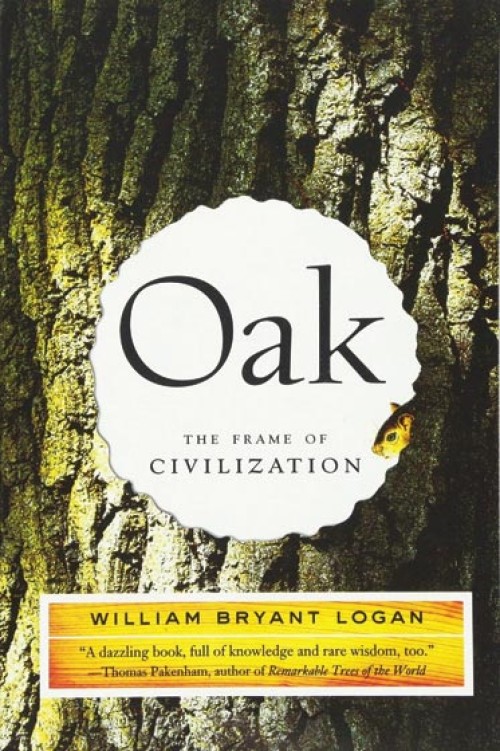by William Bryant Logan
W. W. Norton and Co., 2005
Long an admirer of oaks, I was pleased to receive a copy of arborist William Bryant Logan’s book for Christmas last year. In its 300 pages about acorns and the people who ate them, about oak forests and the people who cut and used their wood and bark, and about much more, Logan added tenfold to my knowledge of the subject. Sprinkled among the author’s invariably fine sentences are gems of botany, history, and philosophy, along with expressions arising from oak and its users. “In for the long haul,” describing a person who perseveres despite difficulties, came from hauling oak with oxen and horses to coastal shipyards. Whole neighborhoods were in for the long haul, stripping bark for tanning, felling trees and shaping the timbers to the ship’s needs with axes, gathering chips for fuel, and finally the difficult days transporting the wood on poor roads.
Logan, from his imagined perches in the crowns of oaks and from tunnels down among their roots, sees forests and people long entwined. He weaves human history, biology, evolution, continental drift, and carpentry into seamless baskets of information that make sense and leave the reader wanting more. After a super chapter on the coopers’ practical art, their medium oak, he writes: “Industry did to craft what Babylonian agriculture did to hunting and gathering. It caused a tremendous increase in output, but at high human and environmental cost. Industry often starts as a liberator but ends as a slaver because it cannot control itself.”
Barrels and buckets are now machine-molded or of stamped plastic. Largely gone is the craftsmanship that came from working with natural materials: “Human beings show restraint when they value, worship, and respect what they encounter. Value comes from understanding, and from understanding intimately. Humans in the age of oak had to confront the resistance of their materials every day. Memory, reason, and skill wove a world of oak.” Ships, cathedrals, and millions of essential barrels and buckets were made well by skilled craftsmen. Logan wisely goes on about much more than basic materials and tools. He rings the world with ships of oak.
Oak was the material of beautiful Viking ships that flexed like fish and gave ships more speed. Later, the mighty British merchant marine and navy of thousands of oaken ships took over much of the world. Logan tells of the oak’s characteristics and the details of construction that provided the great strength needed in stormy, uneven seas. America’s first ship builders were British immigrants happy in a new land of many oak trees, and later generations launched thousands of ships from New England’s shores. It was the builders who knew of both trees and ships as good blacksmiths know of iron and the requirements of what they fashion.
Early on, before agriculture and sophisticated tools, acorns provided a staple food for peoples in the temperate latitudes of the planet where oaks grow. The Indians of California were husking and grinding acorns for flour up until their demise a century ago. It was also an important food here in New England for the Native Americans before the English wood-cutters took their trees for ships, buildings, and firewood. If you want to try acorn flour, you’ll find it today in Korean markets. It is tasteless but more filling over longer periods than grains. The Indians and Logan in his trials added supplements such as insects and berries to get some taste. Acorns were a perfect food for hunter-gatherers; they stored well for long periods in both dry caches and those alongside cold streams.
The author’s history and botany in Oak (published some 12 years ago, now) make it the best book on trees and their cultural significance that I have read. Try it; this review has only chipped away a bit at its many branches.


